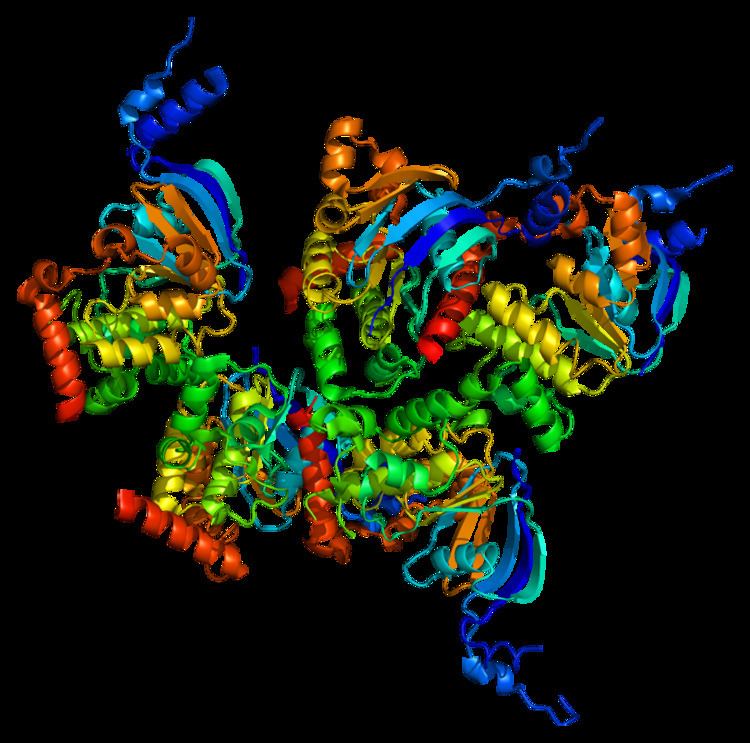EC number 3.6.3.49 | Entrez 1080 | |
 | ||
Aliases CFTR, ABC35, ABCC7, CF, CFTR/MRP, MRP7, TNR-dJ760C5.1, cystic fibrosis transmembrane conductance regulator External IDs OMIM: 602421 MGI: 88388 HomoloGene: 55465 GeneCards: CFTR | ||
Cystic fibrosis transmembrane conductance regulator (CFTR) is a membrane protein and chloride channel in vertebrates that is encoded by the CFTR gene.
Contents
- Gene
- Mutations
- List of common mutations
- Structure
- Location and function
- Interactions
- Related conditions
- Drug target
- References
The CFTR gene codes for an ABC transporter-class ion channel protein that conducts chloride and thiocyanate ions across epithelial cell membranes. Mutations of the CFTR gene affecting chloride ion channel function lead to dysregulation of epithelial fluid transport in the lung, pancreas and other organs, resulting in cystic fibrosis. Complications include thickened mucus in the lungs with frequent respiratory infections, and pancreatic insufficiency giving rise to malnutrition and diabetes. These conditions lead to chronic disability and reduced life expectancy. In male patients, the progressive obstruction and destruction of the developing vas deferens (spermatic cord) and epididymis appear to result from abnormal intraluminal secretions, causing congenital absence of the vas deferens and male infertility.
Gene
The gene that encodes the human CFTR protein is found on chromosome 7, on the long arm at position q31.2. from base pair 116,907,253 to base pair 117,095,955. CFTR orthologs occur in the jawed vertebrates.
The CFTR gene has been used in animals as a nuclear DNA phylogenetic marker. Large genomic sequences of this gene have been used to explore the phylogeny of the major groups of mammals, and confirmed the grouping of placental orders into four major clades: Xenarthra, Afrotheria, Laurasiatheria, and Euarchonta plus Glires.
Mutations
Nearly two thousand cystic fibrosis-causing mutations have been described. The most common mutation, ΔF508 results from a deletion (Δ) of three nucleotides which results in a loss of the amino acid phenylalanine (F) at the 508th position on the protein. As a result, the protein does not fold normally and is more quickly degraded. The vast majority of mutations are infrequent. The distribution and frequency of mutations varies among different populations which has implications for genetic screening and counseling.
Mutations consist of replacements, duplications, deletions or shortenings in the CFTR gene. This may result in proteins that may not function, work less effectively, are more quickly degraded, or are present in inadequate numbers.
It has been hypothesized that mutations in the CFTR gene may confer a selective advantage to heterozygous individuals. Cells expressing a mutant form of the CFTR protein are resistant to invasion by the Salmonella typhi bacterium, the agent of typhoid fever, and mice carrying a single copy of mutant CFTR are resistant to diarrhea caused by cholera toxin.
List of common mutations
The most common mutations among caucasians are:
Structure
The CFTR gene is approximately 189 kb in length, with 27 exons and 26 introns. CFTR is a glycoprotein with 1480 amino acids. The protein consists of five domains. There are two transmembrane domains, each with six spans of alpha helices. These are each connected to a nucleotide binding domain (NBD) in the cytoplasm. The first NBD is connected to the second transmembrane domain by a regulatory "R" domain that is a unique feature of CFTR, not present in other ABC transporters. The ion channel only opens when its R-domain has been phosphorylated by PKA and ATP is bound at the NBDs. The carboxyl terminal of the protein is anchored to the cytoskeleton by a PDZ-interacting domain.
Location and function
CFTR functions as an ATP-gated anion channel, increasing the conductance for certain anions (e.g. Cl−) to flow down their electrochemical gradient. ATP-driven conformational changes in CFTR open and close a gate to allow transmembrane flow of anions down their electrochemical gradient. This in contrast to other ABC proteins, in which ATP-driven conformational changes fuel uphill substrate transport across cellular membranes. Essentially, CFTR is an ion channel that evolved as a 'broken' ABC transporter that leaks when in open conformation.
The CFTR is found in the epithelial cells of many organs including the lung, liver, pancreas, digestive tract, reproductive tract, and skin. Normally, the protein moves chloride and thiocyanate ions (with a negative charge) out of an epithelial cell to the covering mucus. Positively charged sodium ions follow passively, increasing the total electrolyte concentration in the mucus, resulting in the movement of water out of the cell via osmosis.
In epithelial cells with motile cilia lining the bronchus and the oviduct, CFTR is located on the cell membrane but not on cilia. In contrast, ENaC (Epithelial sodium channel) is located along the entire length of the cilia.
In sweat glands, defective CFTR results in reduced transport of sodium chloride and sodium thiocyanate in the reabsorptive duct and therefore saltier sweat. This was the basis of a clinically important sweat test for cystic fibrosis before genetic screening was available.
Interactions
Cystic fibrosis transmembrane conductance regulator has been shown to interact with:
It is inhibited by the anti-diarrhoea drug crofelemer.
Related conditions
Drug target
CFTR has been a drug target in efforts to find treatments for related conditions. Ivacaftor (trade name Kalydeco, developed as VX-770) is a drug approved by the FDA in 2012 for people with cystic fibrosis who have specific CFTR mutations Ivacaftor was developed by Vertex Pharmaceuticals in conjunction with the Cystic Fibrosis Foundation and is the first drug that treats the underlying cause rather than the symptoms of the disease. Called "the most important new drug of 2012", and "a wonder drug" it is one of the most expensive drugs, costing over US$300,000 per year, which has led to criticism of Vertex for the high cost.
